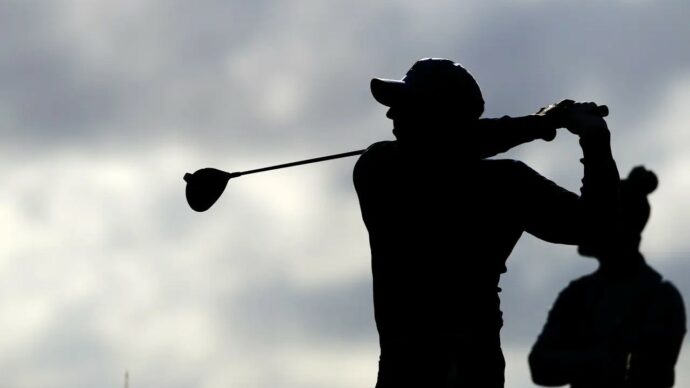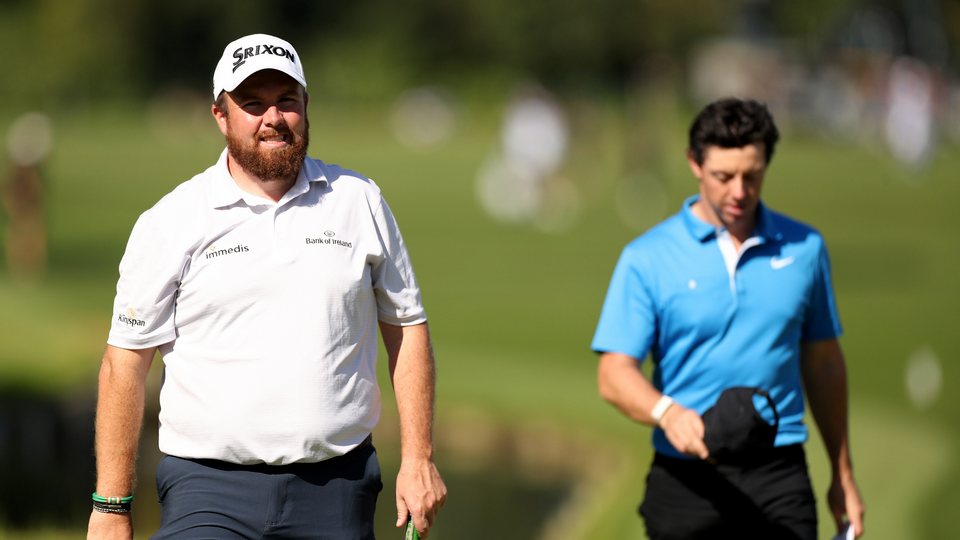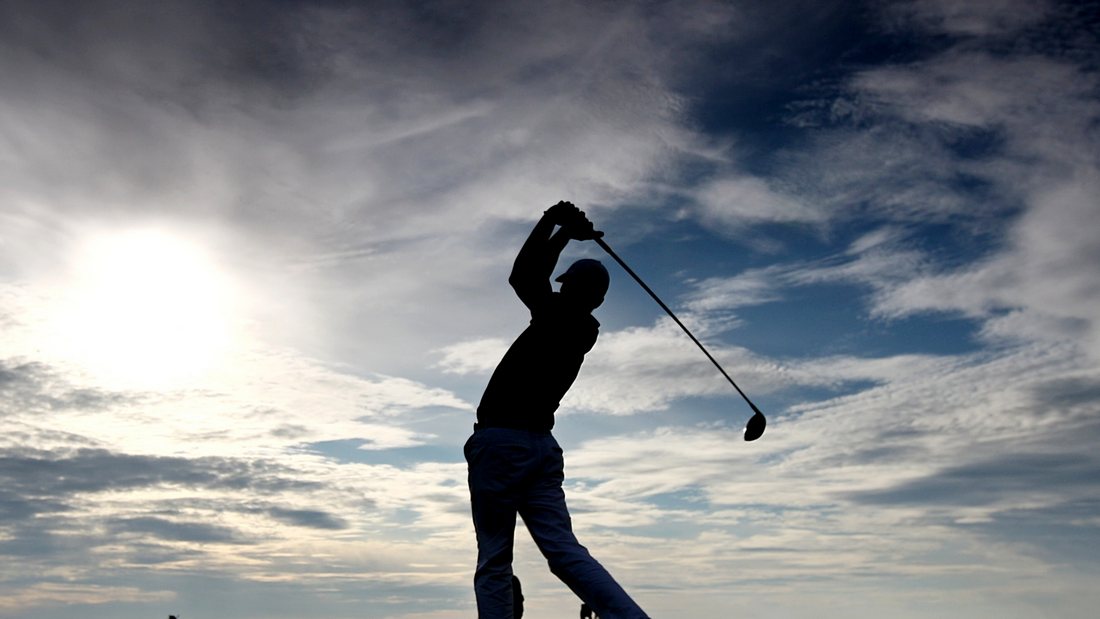Covering all the angles, Ticking all the boxes
‘Matching up’ the movement of the hands/arms with the rotation of the body is golf’s Holy Grail – the ultimate expression of co-ordination, rhythm and timing that produces effortless speed and solid ball striking from tee to green. In full flow, a golf swing is a symphony of logical and connected movement, and it all starts here, at the set-up.
I have always considered myself fortunate to have studied and learned from one of the very best in the business, David Leadbetter. And during those early years in my career, assisting ‘Lead’ in his work with Nick Faldo proved especially beneficial in learning all about the extra weight of importance placed on the fundamentals for players over six feet tall. Sir Nick is 6’5”; our model over the course of this feature, 1-handicap Richard Ackland, stands 6’6”!
Clearly, the key issue for players of exceptional height is one of controlling the long levers they have at their disposal – the arms and the legs. Creating a wide swing arc is not going to be a problem (there is huge potential for speed built in to this set-up position), but co-ordinating the movement of those levers with the rotation of the body is vital in terms of making and repeating a consistent tempo.
Faldo worked tirelessly on his set-up and the first move away from the ball in a bid to inspire a chain reaction that would tick over as if he were on auto pilot – he understood how vital these preparatory positions are. And that’s exactly the direction this lesson with Richard is going to take. One that can equally help you.
First move: Keep it all 'together' as you push back
Long levers are great when it comes to generating clubhead speed with a wide swing arc, but to do that effectively you have to synchronise the movement of the club, your arms and body right from the word ‘go’. Any tendency to pick the club up with independent hand action here makes it virtually impossible to achieve a consistent top of- the-backswing position – and after that it’s a lottery.
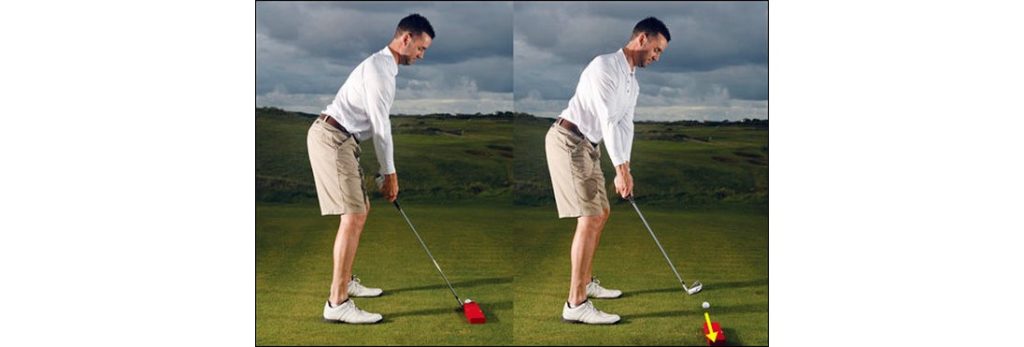
- (Left) Think about your angles– bend from the hips to create this distinct spine angle, allowing the arms to hang down from the shoulders
- (Right) Sensation of keeping upper arms on the chest assist in the ‘togetherness’ of this first move
So a great rehearsal drill on the range is to use a small piece of wood by way of creating a little resistance as you focus on starting the club away from the ball. Take a midiron and simply feel yourself sweeping that piece of wood back along the ground as you make your first move. To do this with some authority you automatically work the arms and the stomach/core muscles ‘together’ – which is precisely the object of the exercise. See how the hands remain passive as Richard sweeps the block of wood out of the way, arms and torso in sync, creating the textbook first move in the process.
I urge my students to hit balls using this drill; as the benefits of the exercise become ingrained, so you will find that you enjoy the sensation of a much better co-ordinated move away from the ball, a togetherness that will benefit the sequence as a whole.
To consolidate the feeling of this move away, make a few rehearsal swings without a club, your hands crossed, as you see Richard doing here below. Place the back of the right hand against the back of the left, and exert pressure with the right to swing the left arm across your chest.
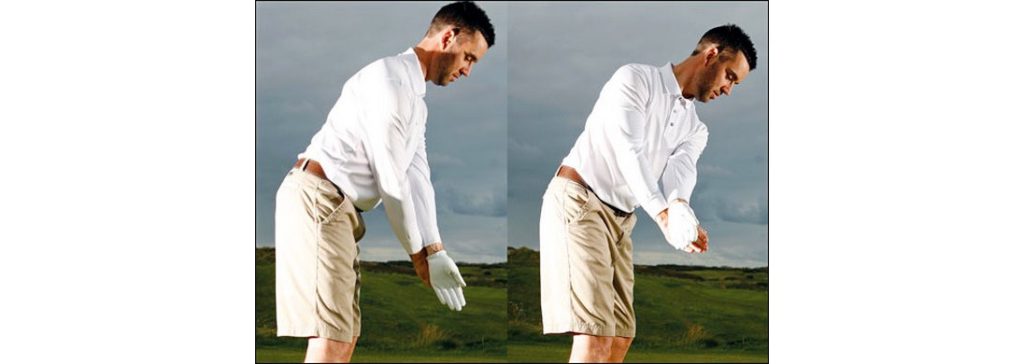
- Whatever your height, this is one of the best exercises there is to familiarise yourself with the sensation of the arms working correctly and in tandem with the movement of your body.
- With the back of the right hand resting on the back of the left in set-up posture (1), the key is to exert pressure with the back of your right hand to initiate the backswing – feel the way the left arm is drawn across your chest (2). In just a few minutes you will be enjoying a textbook first move away from the ball

- A slight lateral movement of the head is perfectly OK as you start back; in fact, that gentle‘bump’ to the right can assist in the process of rotating the upper body, encouraging a full shoulder turn behind the ball. For tall players, this slight lateral move also helps to get the chest over the right knee as you turn and wind into that right side – that’s a good ‘feel’ as you get fully wound up
All ‘Set’ en route to the top...
A lot of golfers tie themselves in knots when it comes to identifying ‘plane’ and getting the club into the desired slot on the way to the top of the swing. But here’s how you can simplify the problem – and it’s a principle that works whether you’re 6’6” or 5’4”.
Working the club away from the ball with a co-ordinated first move gives you a sense of momentum – and the key is now to build on that as you involve the wrists and focus on swinging the club up on its end. Here, at halfway back, with the wrists fully hinged, it should feel quite light in your hands. But how do you know whether or not you are ‘on plane’’? Well, there is no absolute measurements here; all you need to do is work the wrists so that the clubshaft is seen to bisect the area of the right shoulder.
Some people are naturally more upright than others, and would be to the right side of the funnel we have created here; others (and I am encouraging Richard to err on the shallow side) would feel more comfortable on the lower end of this spectrum.
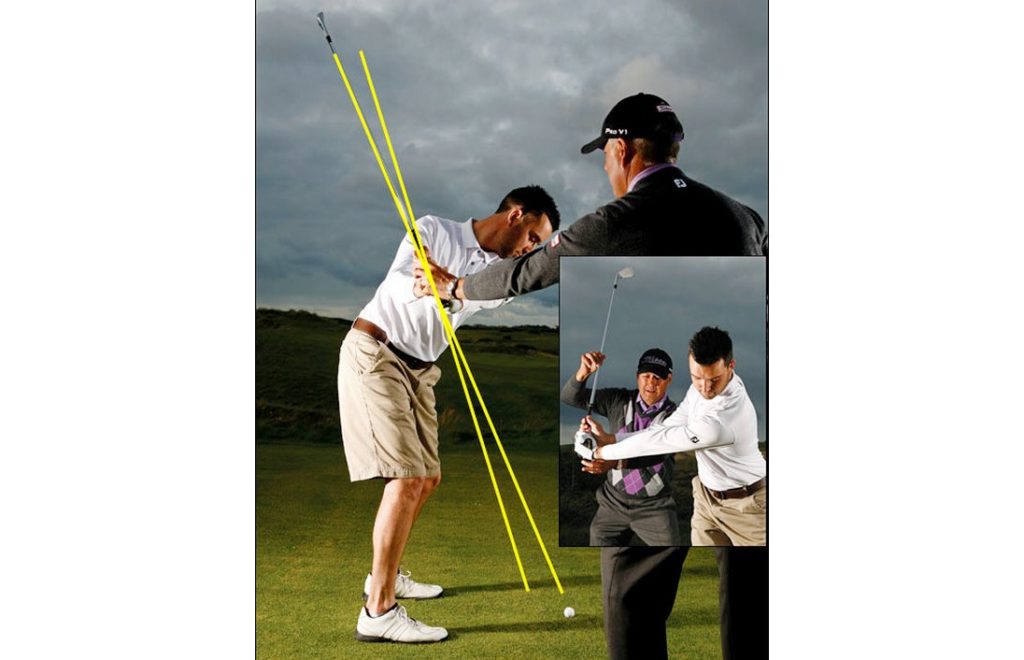
- Looking down the line (main image), I want to see the clubshaft fall somewhere within this spectrum of the right shoulder as the wrists complete their hinge – within this safety zone the club is ‘set’ and the left arm can be seen to be working nicely across the chest. There is a little tolerance here – keep that in mind
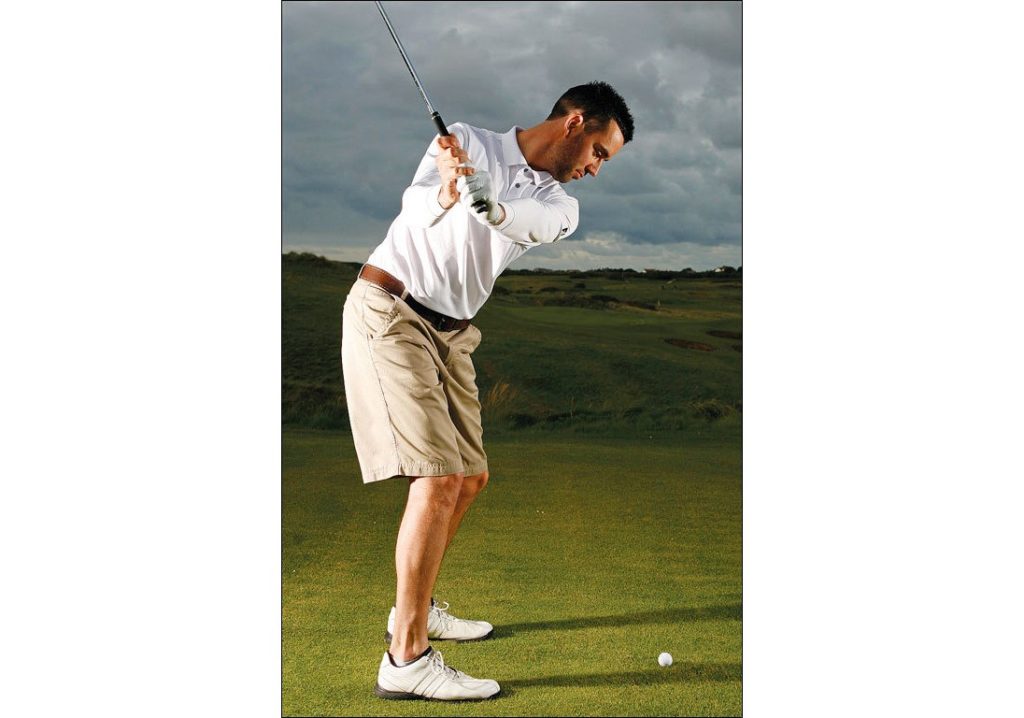

- Having negotiated the first move away from the ball, developing the sensation of this full wrist hinge by the time the left arm reaches the horizontal (top) enables Richard to control the radius of his golf swing. What’s more, from this ‘set’ position, all the player then has to focus on is completing the rotation of the chest and upper body to arrive at a solid position at the top (right). Again, the hands-crossed drill can help you to experience the sensation of the way the arms work and interact with the movement of the body (left), the left arm working on a slightly steeper plane than the shoulders (ready to shallow on the way back down)
- Left arm is slightly higher than the shoulder plane to accommodate the long levers. Clubface is neutral, witness the‘hanging’ toe, which I like. This allows you to freewheel the arms on the way down
Body-action - The heartbeat of every repeating swing
While the emphasis throughout this article is on combining and harmonising the movement of the arms and the body (the Holy Grail I mentioned earlier!), it is important every now and then to stop and remind yourself of the central role a good body action plays in a repeating swing.
This, for me, was Faldo’s greatest asset in his prime; the rhythm and the tempo of his swing was governed by a quality body movement that just wouldn’t quit. The hub of the wheel, if you like, controlled the movement of the arms and the club, and while the exercise you see here may be one of the most basic in golf, it is one the six-times major champion repeated over and over again on the range.

- Feel the stretch as you wind your torso: tall players are best advised to keep their leg and footwork to a minimum (keep that left heel planted as long as you can). Again, note the lateral shift of the upper body, which helps the tall player turn and coil behind the ball
Why not apply the same discipline when you get time to practise?
In between hitting balls, stop every now and again and rehearse this body pivot motion, fine-tuning your angles at the set-up before turning in slow motion and stretching out the key muscles that effectively control the golf swing.
Using a floatie skewered on an old clubshaft makes for a useful point of reference; here, the key point I am making to Richard is that he needs to be aware of a little reluctance in the left hip and thigh as he turns and winds up the bigger muscles in the torso. In other words, there is a resistance that is created in the lower half of the body, and this optimises the stretch as he turns his shoulders.
‘Complete your turn’ – always a great swing thought, and getting that left shoulder behind the ball is one way to achieve doing exactly that.
Feel the flow into transition
Denis Pugh made a fantastic observation last issue in his analysis of Rory McIlroy’s swing, specifically on the quality of the flow of motion Rory exhibits as he shifts through the gears in the change of direction . As Denis said, too many golfers view the top of the backswing as the destination, when it has to be regarded as a passing through area if a player is ever going to enjoy the silky-smooth transition that characterises all good ball strikers.
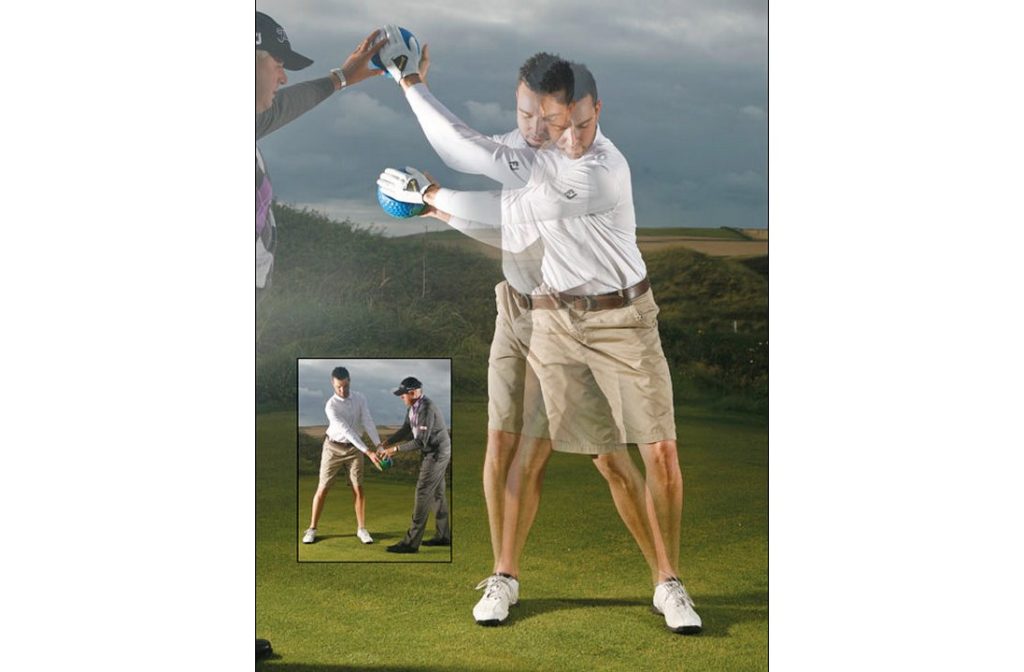
One way to work on improving this quality in your own swing is to use a training ball (or a football) and make a series of rehearsals with the focus on blending together as seamlessly as possible the two halves of your swing. This is a great drill to feel the swing in the arms on the way back and then the fluidity of the transition as you shift into the downswing.
Start the exercise with the ball extended a couple of feet forward (below) and then gathermomentum as you swing it all the way to the top before easing into the return journey. Focus on the quality of your leg action – use the ground as a springboard, transferring your weight towards the target as you settle and the arms fall.
Arms and body together - All the way to the finish
The moment you experience the sensation of the blending together of the two halves of your swing, shifting through the gears with a determined acceleration as you unwind all of that energy into the back of the ball, the true sequence of motion that characterises a flowing golf swing will smack you straight between the eyes.
For when it comes to developing technique, one good move truly does lead to another. The chain reaction you set in train with that co-ordinated first move away from the ball is rewarded with a dynamic and well-sequenced backswing in which the arms and body can be seen to work together for the benefit of the overall motion. And such is the importance of the transition from the top, the return journey is really a series of reactions as you let it all go.

- Feel the left arm stays across the chest and ‘in the slot’ on the way down – crucial for a tall player
The cross-hands drill is again a useful means of experiencing the nature of the relationship between arms and body as you unwind (insets above), and I urge you to use it regularly to keep those good sensations alive in your body. The left arm works up the chest on the way back and shallows as it works across the chest on the way down. In other words, the arm swing is up and down rather than around the body.
Understand the vital role of the finish, too. Fully released, chest and belt buckle facing left of the target, the club supported behind the back of the neck. Balanced. A position you could hold for several seconds without a wobble. With a strong visual of where you hope to get to, you’ll be surprised at the way the links in the chain that actually get you there shuffle into place.
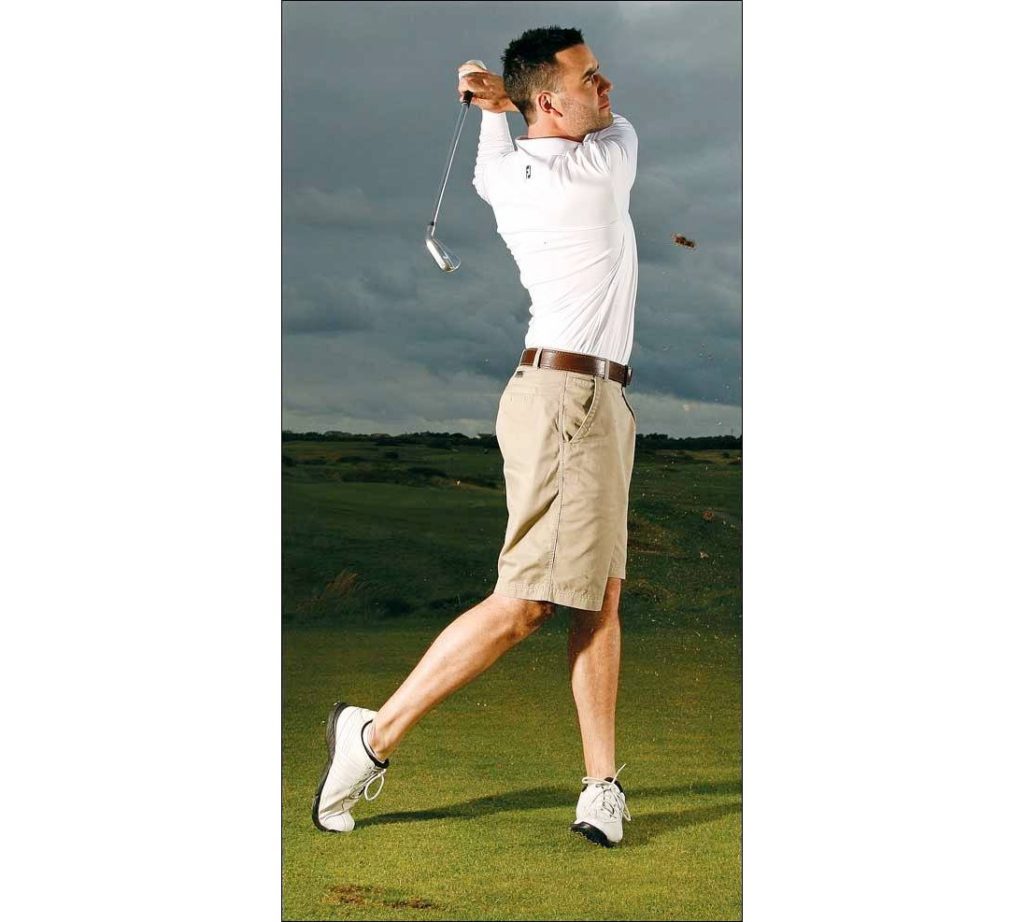
- Forward thinking: visualise a solid finish, and make a concerted effort to get there every time, in balance
